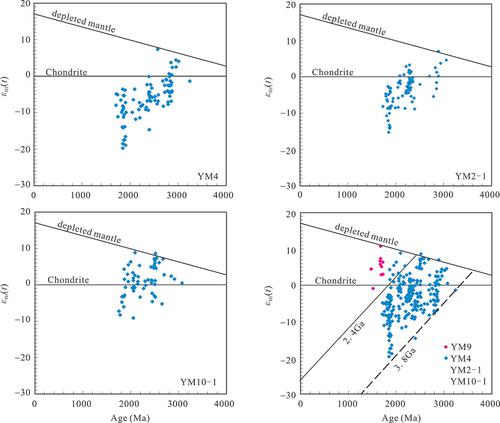当前位置:
X-MOL 学术
›
Acta Geol. Sinica Engl. Ed.
›
论文详情
Our official English website, www.x-mol.net, welcomes your feedback! (Note: you will need to create a separate account there.)
Zircon U–Pb Ages and Lu–Hf Isotope of the Dongchuan Group in Central Yunnan, China, and their Geological Significance
Acta Geologica Sinica-English Edition ( IF 3.3 ) Pub Date : 2020-08-30 , DOI: 10.1111/1755-6724.14560 Kunying HAN 1 , Heng ZhANG 1 , Xiaozhong DING 1 , Liudong REN 1 , Chenglong SHI 1 , Jianfeng PANG 1
Acta Geologica Sinica-English Edition ( IF 3.3 ) Pub Date : 2020-08-30 , DOI: 10.1111/1755-6724.14560 Kunying HAN 1 , Heng ZhANG 1 , Xiaozhong DING 1 , Liudong REN 1 , Chenglong SHI 1 , Jianfeng PANG 1
Affiliation

|
On the southwestern margin of the Yangtze Block, the Dongchuan Group consists of slightly metamorphosed sedimentary rocks, including silty slate, argillaceous slate, clayey slate, arkose, dolomite, and minor volcanic rocks. To date, it is still a controversy over the depositional age and stratigraphic sequence of the Dongchuan Group. In this study, we analyzed five samples of meta‐sedimentary rocks and one sample of meta‐tuff from the Yinmin, Luoxue and Etouchang Formations of the Dongchuan Group in the Yuxi region for detrital zircon U‐Pb ages and Lu‐Hf isotope. The detrital zircon ages of the meta‐sediments vary from 3073 to 1703 Ma, mainly clustered at three periods, from 1889 to 1840, 2490 to 2008 and 2878 to 2844 Ma. The youngest age peak of all the samples is ∼1859 Ma, with the ∊Hf(t) values of the zircons ranging from –20.3 to +4.3 and more than 90% being negative, indicating that the Paleoproterozoic crustal accretion on the southwestern margin of the Yangtze Block was dominated by reworking of the ancient crustal materials involved in the assembly and breakup of the Columbia supercontinent. Another important age range is between 2490 Ma and 2008 Ma, with ∊Hf(t) values from –14.7 to +8.9 and 70% of them are negative, suggesting that the magmatism in the source area was also dominated by reworking and recycling of the ancient crustal materials, with minor juvenile mantle substances added. The detritus was probably derived from the Paleoproterozoic crystalline basement in the southern Yuxi region. The oldest peak age is ∼2847 Ma and the ∊Hf(t) values are from –7.7 to +7.0 with 50% of both positive and negative values, demonstrating a possible ∼2.85 Ga ancient continental nucleus on the southwestern margin of the Yangtze Block and substantial growth in juvenile crust materials during this period. Besides, the weighted average age of the zircons from the meta‐tuff of the Etouchang Formation is 1677 ± 14 Ma. Combining the previous research data and this study, we can constrain the depositional age of the Dongchuan Group in central Yunnan Province to the period from the late Paleoproterozoic to early Mesoproterozoic, slightly earlier than that of the Dongchuan Group in the Dongchuan area near to the southwestern Sichuan Province. The depositional age of the Dongchuan Group is older than that of the Kunyang Group.
中文翻译:

云南中部东川群的锆石U-Pb年龄和Lu-Hf同位素及其地质意义
在扬子地块的西南边缘,东川群由微变质的沉积岩组成,包括粉质板岩,泥质板岩,黏土板岩,阿科斯,白云岩和次要火山岩。迄今为止,关于东川集团的沉积年龄和地层层序仍存在争议。在这项研究中,我们分析了玉溪地区东川组的银敏,洛学和峨头塘组的5个准沉积岩样品和1个准凝灰岩样品的碎屑锆石U-Pb年龄和Lu-Hf同位素。准沉积物的碎屑锆石年龄在3073至1703 Ma之间变化,主要集中在三个时期,即1889至1840、2490至2008和2878至2844 Ma。所有样品的最小年龄峰~1859马,用ε铪(t)的锆石值介于–20.3至+4.3之间,且90%以上为负值,表明扬子地块西南缘的古元古代地壳增生主要是由参与组装和破碎的古代地壳材料的返修所主导的哥伦比亚超大陆。另外一个重要的年龄范围是2490 Ma和2008年马之间,ε铪(ŧ)值从–14.7到+8.9,其中70%为负值,这表明源区的岩浆作用也主要是对古代地壳材料进行了重新加工和回收,并添加了少量的少年地幔物质。碎屑可能来自于玉溪南部地区的古元古代晶体基底。最古老的高峰年龄是~2847马和ε铪(ŧ)值从–7.7到+7.0,正负值均为50%,表明扬子块西南缘可能有约2.85 Ga的古代大陆核,在此期间幼年地壳材料大量增加。此外,鄂图塘组间凝灰岩中锆石的加权平均年龄为1677±14 Ma。结合以前的研究数据和研究结果,我们可以将云南中部东川组的沉积年龄限制在古元古代晚期至中元古代以前,比西南近东川地区的东川组稍早一些。四川。东川组的沉积年龄比昆阳组的沉积年龄大。
更新日期:2020-08-30
中文翻译:

云南中部东川群的锆石U-Pb年龄和Lu-Hf同位素及其地质意义
在扬子地块的西南边缘,东川群由微变质的沉积岩组成,包括粉质板岩,泥质板岩,黏土板岩,阿科斯,白云岩和次要火山岩。迄今为止,关于东川集团的沉积年龄和地层层序仍存在争议。在这项研究中,我们分析了玉溪地区东川组的银敏,洛学和峨头塘组的5个准沉积岩样品和1个准凝灰岩样品的碎屑锆石U-Pb年龄和Lu-Hf同位素。准沉积物的碎屑锆石年龄在3073至1703 Ma之间变化,主要集中在三个时期,即1889至1840、2490至2008和2878至2844 Ma。所有样品的最小年龄峰~1859马,用ε铪(t)的锆石值介于–20.3至+4.3之间,且90%以上为负值,表明扬子地块西南缘的古元古代地壳增生主要是由参与组装和破碎的古代地壳材料的返修所主导的哥伦比亚超大陆。另外一个重要的年龄范围是2490 Ma和2008年马之间,ε铪(ŧ)值从–14.7到+8.9,其中70%为负值,这表明源区的岩浆作用也主要是对古代地壳材料进行了重新加工和回收,并添加了少量的少年地幔物质。碎屑可能来自于玉溪南部地区的古元古代晶体基底。最古老的高峰年龄是~2847马和ε铪(ŧ)值从–7.7到+7.0,正负值均为50%,表明扬子块西南缘可能有约2.85 Ga的古代大陆核,在此期间幼年地壳材料大量增加。此外,鄂图塘组间凝灰岩中锆石的加权平均年龄为1677±14 Ma。结合以前的研究数据和研究结果,我们可以将云南中部东川组的沉积年龄限制在古元古代晚期至中元古代以前,比西南近东川地区的东川组稍早一些。四川。东川组的沉积年龄比昆阳组的沉积年龄大。



























 京公网安备 11010802027423号
京公网安备 11010802027423号